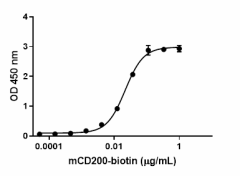- Regulatory Status
- RUO
- Other Names
- OX-2 membrane glycoprotein, OX-2, OX2, MRC OX-2, MOX1, MOX2, My033
- Ave. Rating
- Submit a Review
- Product Citations
- publications

-

When mouse CD200R1-Fc Chimera is immobilized at 0.5 µg/mL, biotinylated mouse CD200-Fc Chimera binds with an EC50 of 6 - 24 ng/mL. HRP Avidin (Cat. No. 405103) was used to detect the binding. -

Stability testing for Biotinylated Recombinant Mouse CD200-Fc Chimera Protein. Biotinylated Recombinant Mouse CD200-Fc Chimera Protein was aliquoted in PBS, pH 7.2, 5% Glycerol at 0.2 mg/mL. One aliquot was frozen and thawed four times (4x Freeze/Thaw), and compared to a control kept at 4°C (Control). The samples were tested in a binding assay with mouse CD200R1-Fc Chimera .
CD200 (OX-2) is a 45 kD cell surface glycoprotein that belongs to the immunoglobulin superfamily (IgSF). CD200 is composed of a 202 amino acid extracellular domain containing two IgSF domains, a 27 amino acid transmembrane segment, and a 19 amino acid cytoplasmic domain. CD200 is the only known ligand of the CD200R family and it is highly conserved in the CNS, expressed mainly by neurons and vascular endothelium. It is also present in most peripheral cell types, thymocytes, T and B cells, and dendritic cells. CD200 and CD200R interact with each other through N-terminal IgSF domains. Their interaction plays important roles in negatively regulating immune responses, and attenuating autoimmune diseases and excessive inflammatory responses against pathogens. High expression of CD200 in the CNS is thought to be a mechanism of constitutive immune suppression, and is developmentally regulated in the mouse brain. Deficiency in neuronal CD200 may explain the chronic inflammation in human neurodegenerative diseases such as Alzheimer's, Parkinson's, and multiple sclerosis. The CD200 and CD200R interaction has also been shown to play an important role in the regulation of anti-tumor immunity, and overexpression of CD200 has been reported in a number of malignancies, including CLL, as well as on cancer stem cells.
Product DetailsProduct Details
- Source
- Mouse CD200, amino acids Gln31-Gly232 (Accession # O54901) with a C-terminal human IgG1 Fc tag was expressed in 293E cells.
- Molecular Mass
- The unlabeled 452 amino acid recombinant protein has a predicted molecular mass of approximately 50 kD. The DTT-reduced proteins migrate at approximately 70 kD, and non-reduced proteins migrate at approximately 140 kD by SDS-PAGE. The predicted N-terminal amino acid is Thr.
- Purity
- >95%, as determined by Coomassie stained SDS-PAGE.
- Formulation
- 0.22 µm filtered protein solution is in PBS, pH 7.2, 5% Glycerol.
- Endotoxin Level
- Less than 0.01 ng per µg cytokine as determined by the LAL method.
- Concentration
- 10 and 25 µg sizes are bottled at 200 µg/mL. 100 µg size and larger sizes are lot-specific and bottled at the concentration indicated on the vial. To obtain lot-specific concentration and expiration, please enter the lot number in our Certificate of Analysis online tool.
- Storage & Handling
- Unopened vial can be stored between 2°C and 8°C for one month, at -20°C for six months, or at -70°C for one year. For maximum results, quick spin vial prior to opening. Stock solutions should be prepared at no less than 50-100 µg/mL in sterile buffer (PBS, HPBS, DPBS, and EBSS) containing carrier protein such as 0.2 - 1% BSA or HSA and stored in working aliquots at -20°C to -70°C. Avoid repeated freeze/thaw cycles.
- Activity
- When mouse CD200R1-Fc Chimera is immobilized at 0.5 µg/mL, biotinylated mouse CD200-Fc Chimera binds with an EC50 of 6 - 24 ng/mL. HRP Avidin (Cat. No. 405103) was used to detect the binding.
- Application
-
Bioassay
- Application Notes
-
BioLegend carrier-free recombinant proteins provided in liquid format are shipped on blue ice. Our comparison testing data indicates that when handled and stored as recommended, the liquid format has equal or better stability and shelf-life compared to commercially available lyophilized proteins after reconstitution. Our liquid proteins are verified in-house to maintain activity after shipping on blue ice and are backed by our 100% satisfaction guarantee. If you have any concerns, contact us at tech@biolegend.com.
Antigen Details
- Structure
- Disulfide-linked homodimer, biotinylated via amines
- Distribution
-
CD200 is widely expressed with the highest expression level in the chorionic villi.
- Function
- Costimulates T-cell proliferation. May regulate myeloid cell activity in a variety of tissues.
- Interaction
- Mast cells, basophils, macrophages, and dendritic cells
- Ligand/Receptor
- CD200R1
- Bioactivity
- Measured by its ability to bind mouse CD200R1
- Cell Type
- B cells, Basophils, Endothelial cells, Macrophages, Mast cells, Neurons, T cells, Thymocytes
- Biology Area
- Immuno-Oncology, Immunology, Neuroinflammation, Neuroscience
- Molecular Family
- CD Molecules
- Antigen References
-
- Hernangómez M, et al. 2014. Curr Pharm Des. 20:4707-22.
- Walker DG and Lue LF. 2013. Future Neurol. 10.2217/fnl.13.14.
- Wright GJ, et al. 2003. J Immunol. 171: 3034-46.
- Vaine CA and Soberman RJ. 2014. Adv Immunol. 121:191-211.
- Minas K and Liversidge J. 2006. Crit Rev Immunol. 26(3): 213-30.
- Wang XJ, et al. 2007. J Neuroimmune Pharmacol. 2(3): 259-64.
- Wong KK, et al. 2010. J Leuko Biol. 88(2): 361-72.
- Gene ID
- 17470 View all products for this Gene ID
- UniProt
- View information about CD200 on UniProt.org

 Login / Register
Login / Register 














Follow Us